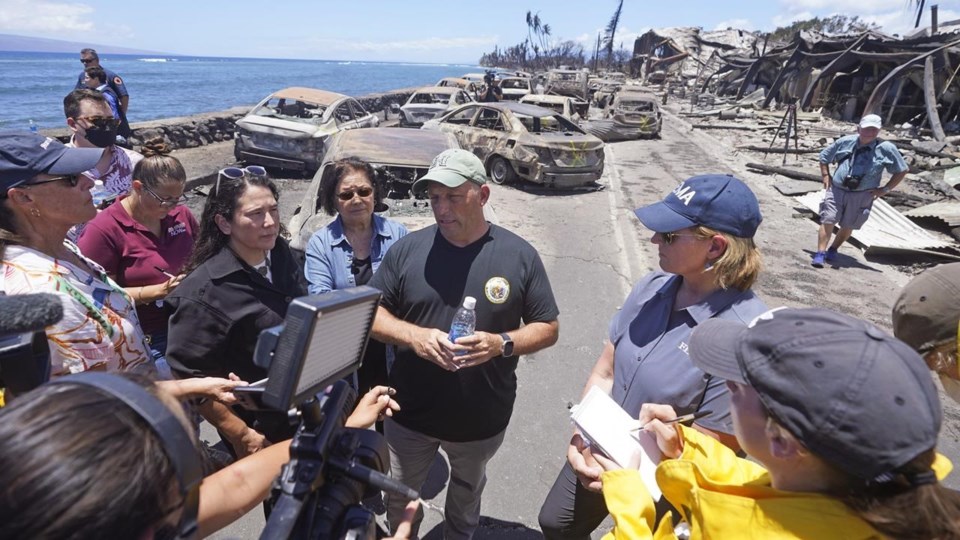LAHAINA, Hawaii (AP) — Richy Palalay so closely identifies with his Maui hometown that he had a tattoo artist permanently ink “Lahaina Grown” on his forearms when he was 16.
But a chronic housing shortage and an influx of second-home buyers and wealthy transplants have been displacing residents like Palalay who give Lahaina its spirit and identity.
A fast-moving wildfire that incinerated much of the compact coastal settlement last week has multiplied concerns that any homes rebuilt there will be targeted at affluent outsiders seeking a tropical haven. That would turbo-charge what is already one of Hawaii’s gravest and biggest challenges: the exodus and displacement of Native Hawaiian and local-born residents who can no longer afford to live in their homeland.
“I’m more concerned of big land developers coming in and seeing this charred land as an opportunity to rebuild,” Palalay said Saturday at a shelter for evacuees.
Hotels and condos “that we can’t afford, that we can’t afford to live in — that’s what we’re afraid of,” he said.
Palalay, 25, was born and raised in Lahaina. He started working at an oceanfront seafood restaurant in town when he was 16 and worked his way up to be kitchen supervisor. He was training to be a sous chef.
Then came Tuesday’s wildfire, which lay waste to its wooden homes and historic streets in just a few hours, killing at least 93 people to become the deadliest wildfire in the U.S. in a century.
Maui County estimates more than 80% of the more than 2,700 structures in the town were damaged or destroyed and 4,500 residents are newly in need of shelter.
The blaze torched Palalay’s restaurant, his neighborhood, his friends’ homes and possibly even the four-bedroom house where he pays $1,000 monthly to rent one room. He and his housemates haven’t had an opportunity to return to examine it themselves, though they’ve seen images showing their neighborhood in ruins.
He said the town, which was once the capital of the former Hawaiian kingdom in the 1800s, made him the man he is today.
“Lahaina is my home. Lahaina is my pride. My life. My joy,” he said in a text message, adding that the town has taught him “lessons of love, struggle, discrimination, passion, division and unity you could not fathom.”
The median price of a Maui home is $1.2 million, putting a single-family home out of reach for the typical wage earner. It’s not possible for many to even buy a condo, with the median condo price at $850,000.
Sterling Higa, the executive director of Housing Hawaii’s Future, a nonprofit organization that advocates for more housing in Hawaii, said the town is host to many houses that have been in the hands of local families for generations. But it’s also been subject to gentrification.
“So a lot of more recent arrivals — typically from the American mainland who have more money and can buy homes at a higher price — were to some extent displacing local families in Lahaina,” Higa said. It’s a phenomenon he has seen all along Maui’s west coast where a modest starter home two decades ago now sells for $1 million.
Residents with insurance or government aid may get funds to rebuild, but those payouts could take years and recipients may find it won’t be enough to pay rent or buy an alternate property in the interim.
Many on Kauai spent years fighting for insurance payments after Hurricane Iniki slammed into the island in 1992 and said the same could happen in Lahaina, Higa said.
“As they deal with this — the frustration of fighting insurance companies or fighting (the Federal Emergency Management Agency) — many of them may well leave because there are no other options,” Higa said.
Palalay vows to stay.
“I don’t have any money to help rebuild. I’ll put on a construction hat and help get this ship going. I’m not going to leave this place,” he said. “Where am I going to go?”
Gov. Josh Green, during a visit to Lahaina with FEMA, told journalists that he won’t let Lahaina get too expensive for locals after rebuilding. He said he is thinking about ways for the state to acquire land to use for workforce housing or open space as a memorial for those lost.
“We want Lahaina to be a part of Hawaii forever," Green said. "We don’t want it to be another example of people being priced out of paradise.”
___
McAvoy reported from Wailuku, Hawaii.
Audrey Mcavoy And Claire Rush, The Associated Press



